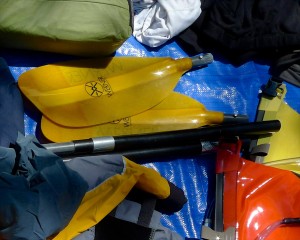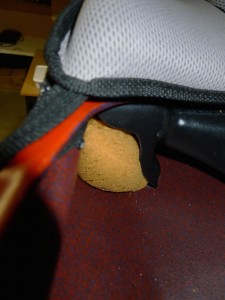The following items merit strong consideration when planning any wilderness excursion, where your spirit of independence and self reliance may be tested.
- TAP
- Sprayskirt
- Throw Rope
- Towline
- Sponge
- Repair
TAP

Breakdown or take-a-part paddles (TAP) are a necessity for any group of kayakers or soloists. It is a requirement, per number of boats, of most agencies controlling river access. Better yet that there is at least one for every two kayaks. In my unexpurgated opinion, every boater should responsibly carry his own TAP, absolutely if they do not have a demonstrably bombproof “combat” roll. An on-board TAP can turn the occurrence of a broken or lost paddle from a major disaster into a temporary, minor annoyance in which one may “continue with style” (…from The Eiger Sanction, my favorite guilty pleasure Dirty Harry/climbing movie). My TAPs remain unused, as I have never either lost or broken a paddle. For that matter, I’ve never even broken a boat. I know, I’m just not trying hard enough.
SRAYSKIRT
Obviously a sprayskirt is as critical to a successful run as either your kayak or paddle. Make certain it fits well and is watertight. In the beginning, I carried a lightweight nylon “pool rolling” skirt for emergency use, but haven’t found anything similar since to use with evolving cockpit sizes. Somehow, carrying a spare still seems like a good idea. I have carried a lightweight nylon cockpit cover on desert rivers in order to prevent blowing sand and troublesome creepy crawlies from unauthorized entry at night.
THROW ROPE
Every kayaker trained to use one, should carry a throw rope in group floats. As a soloist, I no longer carry a rope on open bank, high volume rivers. It takes up valuable space in my boat and has become entirely superfluous, with the possible exceptions of being used as a clothesline or tow line.
TOW LINE
A short length of rope acting as a tow line, attached to either the bow or stern and cleated to the deck, may be of great value in situations with an unpredictably rising river level. This happens frequently on the Colorado below the Glen Canyon Dam. On at least a couple of occasions I have found my boat securely hitched to tamarisk, waters having risen far above the previous evening’s beaches, lapping gently at its hull, while others were chasing theirs through the eddy. Suffice to say, you don’t want to lose your boat on a self support.
SPONGE

Even if you choose not to carry a sponge on day trips, I highly recommend its use at every opportunity when self supporting. Keeping the inside of your boat as dry as possible will go a long way towards ensuring your stowed gear remains dry, whether or not it is contained in “waterproof” stow floats. Turning a boat upside down to remove water, or upending to use a drain hole, if installed, can be quite taxing with 30 to 60 pounds of additional kit, plus water weight. Leaning a kayak on its side and allowing water to drain to the cockpit will allow the boat to be most easily sponged out, keeping as much water as possible from sloshing around in your boat. A sponge can be easily stowed between the seat an inner hull of most boats, or bungied in with a water bottle. A natural sponge is best, but large grouting sponges available at home stores will also do. I am still using the same sponge I received with the bygone outfitting of my original Perception Dancer.
REPAIR
First off, know your boat. If it is prone to needing repairs, make sure you bring everything required to keep it afloat. A small tool kit consisting of nothing more than appropriate screw drivers necessary to address any loosenings may be all that’s necessary. Multi-tools may be adequate here. Bring plenty of duct tape or my new fave, Gorilla Tape. As many do, I keep wraps of it around the shafts of my TAP. There are some interesting boat repair tapes available, similar perhaps to Gorilla Tape. A small tube of Aquaseal is always a good idea for plugging small holes and covering screws, as well as its uses on neoprene and nylon. Long ago, I witnessed camp stoves being used to assist in repairs on plastic boats – boats which would have been better retired before the trip. Think about how the equipment you already have with you may double in repair or emergency situations.
